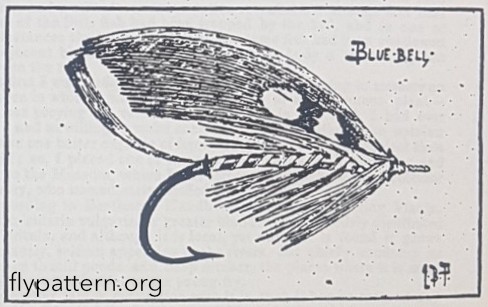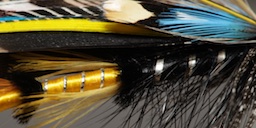From "The fishing gazette" - May 31th, 1884
I DID not intend, until the standard colours were introduced, to commence this subject; but it has been suggested to me that, as some of Major Traherne's patterns were made pretty much with natural material, undyed, I might start this series of articles by illustrating a few of them.
When the standard colours are established, there should be no difficulty whatever in dressing any specimen if it were properly described. It is most disappointing to a salmon fisherman not to be able to get a fly true to pattern - indeed, it is most annoying.
Who has not heard, at one time or another, that "deep sigh" when a new packet of flies has been undone? Does not that sigh suggest all kinds of unmentionable curses?
Now I am almost of opinion that if all the corduroy gods of calumny were to shower their "Billingsgate brogue" upon some of our persistent, though innoncent, manufacturers, it would not prevent odd bits of material - patches of pothouse plumes - being whipped in for the cloak of convenience, which we all so frequently see disfiguring many of their samples.
There really is but one remedy to override this whirlwind of such a contemptible custom, and to overcome this increasing violation, this incorrect and inharmonious dressing; just put "Not known," and, like a dead letter, return the parcel of profaned patterns to the maker.
I am occasionally witnessing the work of one or two of our best men, which "speaks for itself" to anyone who is familiar with the standard patterns; it is naturally well done, and that, too, from memory. Even they would do well to sacrifice this "straightforward reflection," and work upon principle. Let almost anyone advertise and dress flies made true to standard patterns - they would soon glory in their success; they would soon make for themselves a tower of reputation which no thunder-crash could lower, no storm of Time destroy.
"Bluebell" is one of the most useful flies I have seen for many years. Dressed to the required size, it would probably move the sulkiest fish in any river. It has for some time proved itself a tip-top fly, and it is made as follows: -
Tag: Silver twist, and blue silk the same shade as the Macaw feathers.
Tail: Topping.
Butt: Black herl.
Body: Orange silk to that part of the hook midway between the throat and tag; the rest blue silk. The former the same shade as the rind of a darkish orange, the latter the same as in the tag.
Ribbed: Silver lace, and silver tinsel.
Hackle: Blue macaw, from blue silk.
Throat: Yellow macaw.
Wings: Red macaw.
Sides: Jungle fowl.
Horns: Blue macaw, with a topping over.
Head: Black herl.
There are no salmon flies in creation requiring so much patient work to dress well as Major Traherne's. This one is a very simple pattern comparatively, and could be made at a quarter the price of many of his others.
This gentleman, in the stream of Time from practical experience, has stored a rare stock of the great and fundamental truths in angling, and also of the laws of its operation, which are undoubtedly as fixed and unalterable as those which govern the stars.
He has availed himself of every opportunity to develop his talent; he has hurried away from what is generally styled "that snug retreat" - Self; and he is doing the piscatorial world a real good turn by allowing his brilliant patterns to be published, which, in many riversm are simply irresistible.
We are told, and we believe, that the component parts of certain chemical substances, when once their union is dissolved, recede farther and father from each other, as if animated by as strong a repulsion as formerly they were governed by a strong attraction. Now, we should not come to any hasty or adverse opinion about salmon flies by merely handling them, unless we thoroughly understand them.
I may mention that, as a rule, it is only by very long experience we learn that however unsightly or unblending some special shades of feathers may appear in certain lights, they represent when under the water totally opposite appearances with the fibres separated, and the action of the water having changed their tone. And so all "Chemical ruling," or the frame of "Artist's lofty laws," may be "skied" by the artificial entonmologist, for sometimes a little delicate deviation not only grasps excellence, but secures success.
Every fisherman should learn to make his own flies. It is astonishing how one gains by even a little knowledge in this respect, which, like a small hole in a garment, may be the beginning of an extensive one.
Learn, and learn early; for it is then that we are the better adapted for taking correct impressions, so that in the future we may combine those images which, like a spell, have been deposited in our memory.
This pattern can be purchased of the following makers:-
Messrs. Farlow and Co., Strand.
Mr. Bernard, Church Place, Piccadilly.
Mr. James Wright, Sprouston, Kelso.
Mr. Malloch, High Street, Perth
----
Thanks to Todd Kennedy - "Jock Scott", for providing a copy of the original article for this pattern.
|

